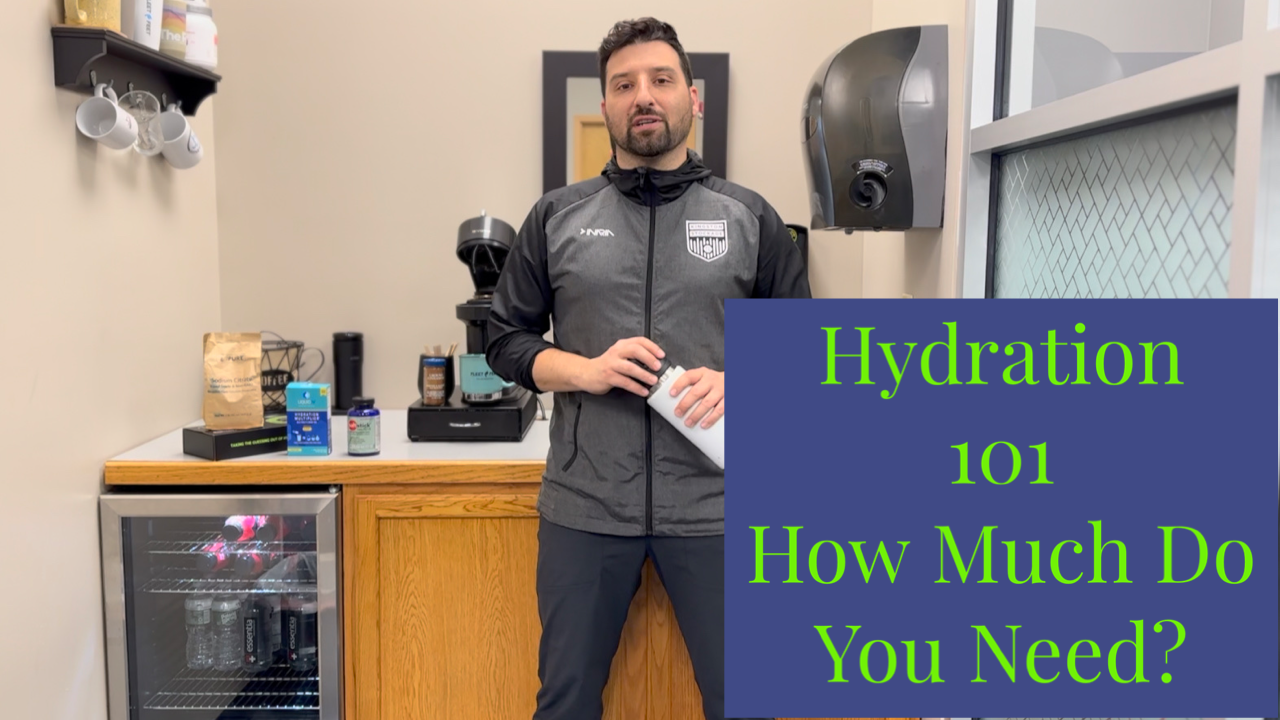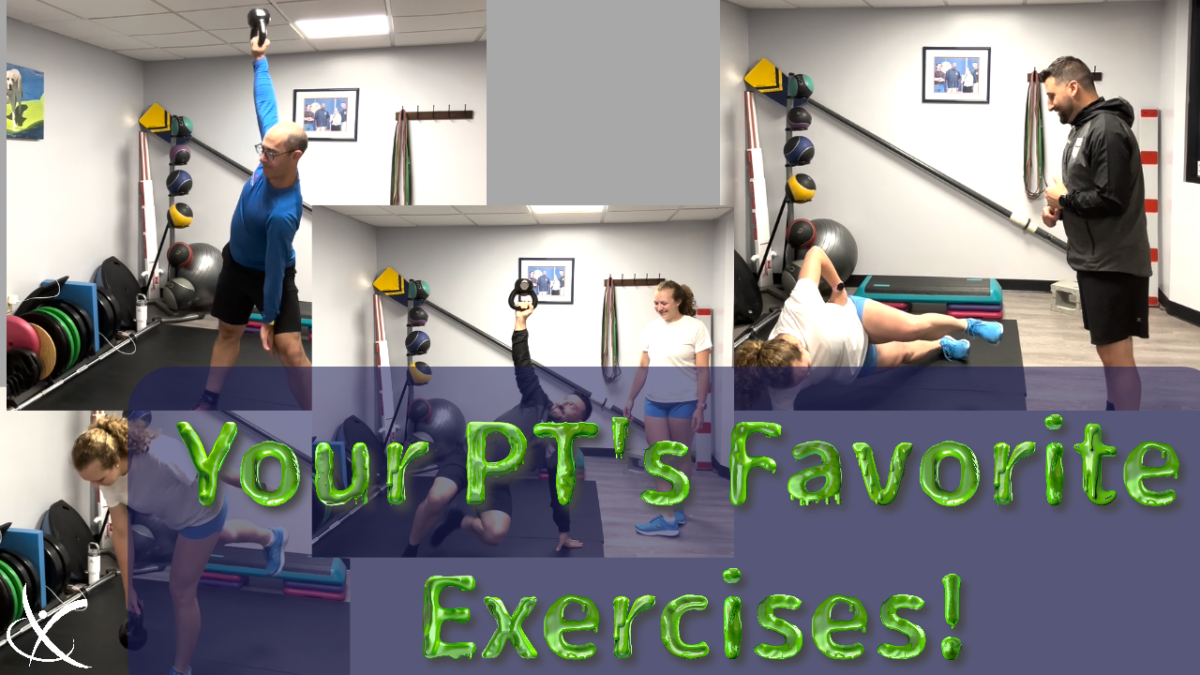
Hydration 101: How much do you need?
June 24, 2023
Sweat Analysis – Nix Biosensor Review
July 23, 2023What Are Physical Therapists’ Favorite Exercises?
No, don’t worry that wasn’t the start of some really bad joke…although maybe it should be. A few days ago we were all sitting around talking about our favorite exercises and we decided to turn the camera on! So if you’d like to watch instead of read this link is for you!
We each got to pick two exercises!
Meg picked:
Single Leg Deadlift
The Single Leg Deadlift is an exercise that demands balance, strength, and focus. It’s a challenging move that can seem deceptively simple, but once you’re in the thick of it, you’ll quickly realize the complexity and effectiveness of this exercise.
Picture yourself standing on one leg, the other extended behind you. Your core is engaged, your back is straight, and your gaze is fixed on a point in front of you. This is the starting position for the Single Leg Deadlift, an exercise that targets your hamstrings, glutes, and core, while also testing your balance and stability.
Performing this exercise requires a slow and controlled movement. You’ll bend at the waist, lowering your torso towards the ground while your free leg extends behind you. It’s a bit like a seesaw, with your standing leg acting as the fulcrum. The goal is to keep your body aligned and balanced, which is easier said than done when you’re on one leg.
The Single Leg Deadlift is a challenging exercise, but it’s also incredibly effective. It’s a full-body workout that not only strengthens your muscles, but also improves your balance and stability. It’s an exercise that may take some time to master, but once you do, you’ll see the benefits in your overall strength and stability.
Kettlebell Windmill
The Kettlebell Windmill is an exercise that combines strength, flexibility, and control in a unique and challenging way. It’s a movement that requires precision and balance, and when executed correctly, it can provide a comprehensive workout for several muscle groups.
Visualize yourself standing tall, a kettlebell securely held overhead in one hand. Your feet are positioned slightly wider than shoulder-width apart, and your gaze is fixed on the kettlebell above. This is your starting point for the Kettlebell Windmill, an exercise that targets your shoulders, core, and hamstrings, while also enhancing your flexibility and stability.
The journey of the Kettlebell Windmill begins as you push your hips out to the side, and slowly lower your torso towards the ground. The kettlebell remains overhead, acting as a beacon guiding your movement. Your free hand traces down the inside of your leg, reaching towards your foot. It’s a bit like a lighthouse beam sweeping across the sea, with your body moving in a controlled, deliberate arc.
The Kettlebell Windmill is a complex exercise, but its benefits are manifold. It’s a full-body workout that not only strengthens your muscles, but also improves your flexibility and stability. It’s an exercise that demands focus and precision, but with practice, you’ll find the Kettlebell Windmill to be a valuable addition to your fitness routine.
John picked:
Lateral Lunge
The Lateral Lunge is an exercise that takes a different direction, quite literally, in your workout routine. Instead of the forward or backward movements that dominate many exercises, this one takes you sideways, challenging your muscles in a new and beneficial way.
Imagine yourself standing tall, feet hip-width apart, and your gaze forward. This is your starting position for the Lateral Lunge, an exercise that targets your glutes, quads, and hamstrings, while also improving your balance and flexibility.
The adventure of the Lateral Lunge begins as you take a large step to the side, bending the knee of your stepping leg while keeping the other leg straight. Your torso lowers as if you’re about to sit on a chair that’s not quite there. It’s a bit like a dance move, where you’re sliding sideways but maintaining your balance and control.
The Lateral Lunge is a dynamic exercise that adds a new dimension to your workout. It not only strengthens your lower body muscles, but also enhances your lateral mobility and stability. It’s an exercise that may feel a bit unusual at first, but with practice, the Lateral Lunge will become a powerful tool in your fitness arsenal.
Side Plank
The Side Plank is an exercise that takes the traditional plank and gives it a twist, literally. Instead of facing the floor, you’re now facing sideways, challenging your body in a new and effective way.
Picture yourself lying on your side, propped up on one elbow with your feet stacked one on top of the other. Your body forms a straight line from head to heels. This is your starting position for the Side Plank, an exercise that targets your obliques, abs, and lower back, while also enhancing your balance and stability.
The journey of the Side Plank begins as you lift your hips off the ground, balancing on the side of your foot and your elbow. Your free hand can either be placed on your hip or extended towards the ceiling. It’s a bit like a teeter-totter, with your body acting as the plank and your elbow and foot serving as the fulcrum.
The Side Plank is a challenging exercise that tests your strength and balance. It not only strengthens your core muscles, but also improves your overall stability. It’s an exercise that may take some time to master, but once you do, the Side Plank will become a cornerstone in your fitness routine.
Justin Picked:
Turkish Getup
The Turkish Get-Up is an exercise that feels more like a carefully choreographed dance than a simple workout move. It’s a multi-step process that requires strength, flexibility, balance, and a good deal of concentration.
Imagine yourself lying flat on your back, one arm extended towards the ceiling holding a kettlebell, and the same-side leg bent at the knee. This is your starting position for the Turkish Get-Up, an exercise that targets virtually every muscle group in your body, from your shoulders and core to your legs and glutes.
The saga of the Turkish Get-Up begins as you roll onto your free side, propping yourself up on your elbow. From there, you’ll transition onto your hand, lift your hips to create a bridge, and sweep your straight leg back to a kneeling position. Finally, you’ll stand up completely, all while keeping the kettlebell overhead and your eyes on it. It’s a bit like a graceful, slow-motion breakdance, with your body moving in a controlled, deliberate sequence.
The Turkish Get-Up is a complex exercise, but its benefits are comprehensive. It’s a full-body workout that not only strengthens your muscles, but also improves your mobility, stability, and coordination. It’s an exercise that demands focus and precision, but with practice, the Turkish Get-Up will become a testament to your fitness prowess.
Banded Deadlift
The Banded Deadlift is an exercise that takes a classic strength move and adds a twist of resistance. It’s a variation that introduces an extra challenge to your muscles, pushing you to work harder and making your workout more effective.
Envision yourself standing tall, feet hip-width apart, a resistance band looped under your feet and held firmly in your hands. This is your starting position for the Banded Deadlift, an exercise that targets your glutes, hamstrings, lower back, and core, while also improving your overall strength and stability.
The journey of the Banded Deadlift begins as you push your hips back and bend your knees, lowering your torso towards the ground while maintaining a straight back. The resistance band adds an extra layer of difficulty, pulling against your upward movement and forcing your muscles to work harder. It’s a bit like trying to lift a heavy object while an invisible force pulls it back down.
The Banded Deadlift is a challenging exercise that tests your strength and endurance. It not only strengthens your lower body and core muscles, but also enhances your overall power and stability. It’s an exercise that may take some time to master, but once you do, the Banded Deadlift will become a powerful ally in your strength training routine.
What do you think? What are some of your favorite Exercises?





